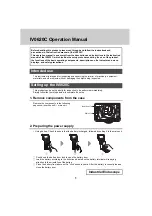
1. AC voltage
2. USB Connector
3. 9-pin RS232C serial connecto r
4. AC power cord connector
2.2.3
USB Output
In the upper left side of the rear panel above the AC
Voltage switch is an industry standard USB output. The new
USB is 2.0 compatible and backwards compatible with USB 1.1 .
See section 4.5 for instructions on use.
2.2.4 RS232C Digital Output
This is an industry standard serial interface which is
configured as a DCE device. Cables are available for
conversion from DCE to DTE for use with PL 9 pin typical
cable.
2.2.5 Power Input
Item 4 to the right o the AC Volta ge switch is the
‘POWE
R INPUT
’
connector. This is an international type of
connector to accept the source of AC power. We provide a
cable with an American type of plug on it. You may have to
cut this plug off and replace it with one which is acceptable in
your area. If you need to do this, be advised that the
green/yello w wire is the GROUND (earth) line. The blue wire
is the
‘NEUTRA
L
’
, and the brown wire is the
‘LINE’ o
r live
wire.
2.2.6 Power Source
To the right of the power input connector is a slide
switch marked
‘AC/B
AT
SOURCE’
. This allows the user to
select either internal battery operation (BAT), or external
power from either Alternating Current (AC) or D.C through
the auxiliary input.
2.2.7 Sensor Input
In the upper right hand corner of the rear panel is the 15
pin connector marked
‘SENSO
R
INPUT’
. This, of course,
is where you plug in the light sensor or detector for measuring
another parameter. The correct internal voltage s for all
International Light detectors are provided in the hardware.
(see section 5.1.2 for connecting custom sensors).
5. Power source select switch
6. Battery access pull knob
7. Detector input
8. Accessory I/O
2.2.8 Accessory Input/Output
Below the sensor input we have the 24 pin card edge
connector marked
‘ACCESSO
RY
INPUT/OUTPUT’
. This
port is used for remote control applications, some obsolete
spectroradiomete r systems, productio n tests, analog output
and for future new product developments (se e section 6.0 for
more on this).
2.2.9 Battery access knob
See 2.2.1 battery replacement on how to use knob.
3. Operation
3.1 Power Selection
The ILT1700 can operate from seven different sources of
power as follows:
•
Six internal Nicad Rechargeable
‘C’
cell batteries
(purchase separately)
•
External DC power supply or battery (8 to 15 VDC)
•
Mobile power (thru cigarette lighter)
•
115 VAC/50-400 Hz (Power cord supplied)
•
90-100 VAC/60-400 Hz (Change plug on power cord
as needed)
•
180-240VAC/50-400 Hz (Change plug on power
cord)
Due to the varied applications and the world wide
market, it has been necessary to offer a very universal
instrument as far as power selection. The internal batteries
are necessary for any application which requires on site
inspections or site surveys, such as health hazard or field
study applications.
9
2.2 REAR PANEL
代理美国International Light辐照计http://www.testeb.com/yiqi/ilt/zhaoduji.html 深圳市格信达科技 电话18823303057 QQ:2104028976











































